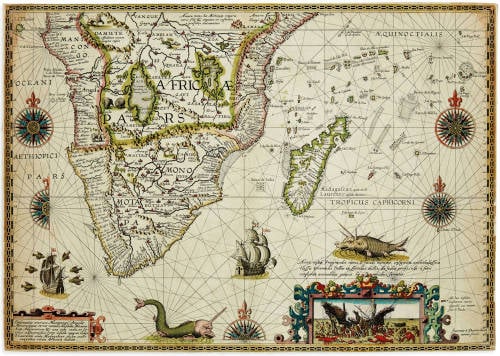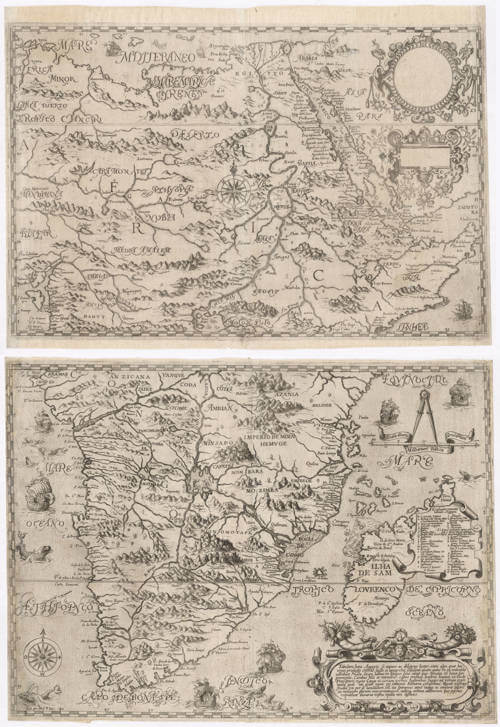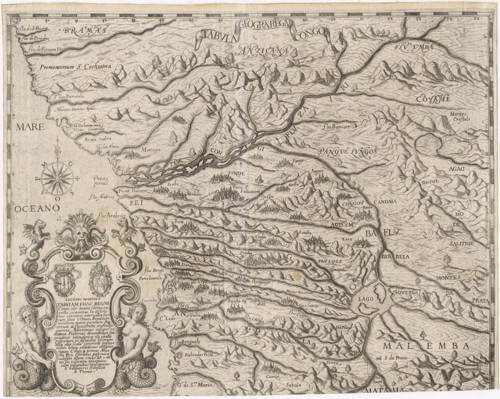Leen Helmink Antique Maps
Petrus Plancius’ illustrious Africa and Indian Ocean Map in original colour
The item below has been sold, but if you enter your email address we will notify you in case we have another example that is not yet listed or as soon as we receive another example.
Stock number: 19037
Small ImageCartographer(s)
Petrus Plancius (biography)
Title
Delineatio orarum Manicongi, Angolæ, Monomotapæ, terræ natalis, Zofalæ, Mozambicæ, Abyssinorum &t: una cum vadis, et sirtibus adjacentibus. Item insulæ magna vulgo S. Laurentij alias Madagascar dictæ, inter maximas totius Orientis habitæ.
First Published
Amsterdam, 1592
This Edition
First and only state of 1592-94
Size
38.5 x 54.5 cms
Technique
Condition
excellent
Price
This Item is Sold
Description
Petrus Plancius' legendary navigation chart of Southern Africa and the Indian Ocean
The first printed navigation chart of the Indian Ocean, and the counterpart of Plancius' Spice Map, which was also engraved by Johannes van Doetecum.
Together with the Spice map, this is the other campaign map that promoted the funding of the first Dutch expedition to the East Indies leading to the founding of the VOC.
FIRST AND ONLY STATE, of exceptional rarity. Only four other copies are known, all in institutions.
It is the first of all printed navigation charts to sail into the Indian Ocean. Issued between 1592-94 by Cornelis Claesz, this is the first and only known state.
Condition
A dark and even impression of the copperplate. Stunning original colour. Excellent collector's condition.
Rarity
Schilder (2003) lists four copies, all in European institutions. No examples outside Europe.
Summary
Designed by Petrus Plancius, this is the earliest printed, most famous, most important, most beautiful, most desirable and rarest of all Indian Ocean navigation charts. The map shows much of the Indian Ocean at a detail never seen before. The map is of utmost importance to early Dutch navigation to the East. For the first Dutch Fleet of 1595-96, and the early VOC fleets, there is no doubt that this was one of their main charts on board, being the most accurate of its day.
Due to its extreme rarity and its splendour, the map is mythical.
The map was designed by Petrus Plancius, engraved by Johannes van Doetecum and sold as a separate chart by Cornelis Claesz’ publishing house. It is richly decorated with compass roses, ships and sea monsters, as well as an inset depicting the loss of the Portuguese admiral ship Santiago, which was one of the most tragic and deadly shipwrecks of the 16th century.
The van Doetecum brothers were from a family of engravers and map publishers working in Deventer and Haarlem from 1587. They engraved maps for Plantijn, de Jode, Waghenaer, Ortelius, Barentsz, Hondius and Linschoten. Baptista van Doetecum also engraved Petrus Plancius’ famous wall map of the world of 1592. Like Plancius 1592 wall map of the world, this map here is based on Portuguese and Spanish sources, which can also be seen from the geographic nomenclature. The two countries were one united kingdom at the time. During an intelligence visit to Lisbon, Cornelis de Houtman had succeeded to secretly buy a set of manuscript charts from Bartholomeo de Lasso. These maps enabled the fast Dutch expansion overseas. Some maps were used also for Jan Huyghen van Linschoten’s famous Itinerario.
This map gives a good insight in the Portuguese cartographical achievements at a time when for reasons of secrecy such information was not permitted to be distributed or printed in the Iberian peninsula.
The map was issued and sold as a loose separate sea chart by the Cornelis Claesz, the most important publisher of his day and a great drive for for the Dutch maritime exploration and expansion. Just four copies of this map are known in one state, all in library and museum collections.
Petrus Plancius (1552-1622)
Born as Peter Platevoet in Flanders, Petrus Plancius studied abroad and became a theologian and a mapmaker.
He produced some globes and maps, including a well-known world map in 1592. He had a great influence on the Dutch Asian expeditions.
Early Years
Peter Platevoet was born in 1552 in the Flanders village of Dranouter. Little is known about his childhood, but it seems that his parents became Protestants. Platevoet studied theology, history, and languages in Germany and England. In England he probably learned about mathematics, astronomy, and geography. When he was older, Platevoet Latinized his name, as was the custom among savants at that time.
In 1576 he became a preacher in West-Flanders, a province in Belgium, and later that year he went to Mechelen, Brussels, and Louvain. In the 1580s he stayed in Brussels for a long time, but when the city surrendered to the duke of Parma, King Philip II of Spain’s governor-general in the Netherlands, in 1585 Petrus Plancius fled to the north. He lived in Amsterdam and became a pastor of the Dutch Reformed Church. From December 1585 until his death on 15 May 1622, he fulfilled his job as preacher. Plancius was a fervent Contra-Remonstrant and discussed many theological issues.
In addition to his thorough knowledge of the Holy Bible, he was well-grounded in the study of cosmography, geography, and cartography. He was not only one of the most talked-about preachers in the Dutch republic, but also one of the important mapmakers of his time.
Early Publications
Petrus Plancius was the first caert-snyder (map cutter) in the Dutch republic to produce waxed grid maps. Therefore, on 12 September 1594 he received a patent for the publication and distribution of the world map for twelve years from the States-General. He was, together with the Flemish engraver and map-maker Jodocus Hondius and the brothers Van Langren, one of the first makers of celestial globes in the Netherlands. His first globe was produced in 1589, a revision of an earlier celestial globe. Among his revisions were four additions to the southern sky: the two Magellanic Clouds (they were unnamed on the globe) and two new constellations, Crux and Triangulus Antarticus. Their positions were taken from reports of explorers.
In 1590 Petrus Plancius made five terrestrial maps for a Dutch edition of the Holy Bible. Two years later he made a well-known world map: Nova et exacta terrarum orbis tabula geographica ac hydrographica (New and exact geographical and hydrographical map of the world). This map contained celestial planispheres in the upper corners on which he added two additional constellations.
Asian Expeditions
Petrus Plancius was one of the driving forces behind the first Dutch expeditions to Asia, assisting with preparations and providing instruction. To avoid encounters with Spain and Portugal, which were already sailing to the East Indies around southern Africa, Plancius decided to try a northeast route around Asia. He supplied maps for the voyage and advised the fleet commander, Willem Barents, in celestial navigation. The northeast voyages of 1594 and 1595 were failures, but a third attempt was made in 1596. It was on that last expedition that Barents’s ship got stuck in the polar ice, and the crew had to spend the winter in Nova Zembla, an island northwest above Russia, in what came to be called the Barents Sea. Late in the spring of the next year, the crew was able to sail south in two small boats. Barents died on the return voyage; the survivors arrived at Amsterdam in November 1597, not having found a northeast passageway.
In 1595, together with Barents, Plancius published a book titled Nieuwe Beschrijvinghe ende Caertboeck van de Middelandtsche Zee (New description and map book of the Mediterranean Sea). In this work he designed a map that was engraved by the well-known globe- and map-maker Hondius.
Because the northeast sea route around Asia did not seem very promising, even before the third voyage a group of Dutch merchants had financed a southern expedition. Plancius again helped with the planning and used the opportunity to conduct scientific research. A theory in the late sixteenth century claimed that a compass needle’s variation from north (its declination) would enable one to determine longitude. Plancius developed his own theory to ascertain longitude at sea by means of magnetic variation. To test that theory during the southern voyage, Plancius taught junior merchant Frederik de Houtman how to measure and record compass declinations. It is known that the method developed by Plancius was used from 1596 onward by mariners.
Plancius also used the voyage to discover southern stars that were not visible from Europe. He taught navigators, especially Pieter Dircksz Keyser, but also other sailors, how to measure star positions with an astrolabe and instructed them to chart the southern sky. From ship records of 1596 it is known that the astrolabe was used to measure the declination of the southern stars.
The Dutch southern expedition, known as the Eerste Shipvaart, or First Voyage, set sail from the port of Texel in April 1595. It reached the East Indies in 1596 and returned to Texel in August 1597. Plancius asked Keyser, the chief pilot on the Hollandia, to make observations to fill in the blank area around the south celestial pole on European maps of the southern sky. Keyser died in Java the following year, but his catalog included 135 new stars arranged in twelve new constellations. Most of them were invented to honor discoveries by sixteenth-century explorers. They were first published on a 1598 celestial globe made by Hondius.
After the foundation of the VOC (Verenigde Oostindische Compagnie, or East India Company) in 1602, Plancius became its first mapmaker. During the first quarter of the seventeenth century, he seemed more interested in preaching than in cartography and cosmography. But still, some of his maps were published during that time. In 1607 he produced a large revised world map. In 1612 he created a celestial globe, and later he designed an Earth and another celestial globe (1614 and 1615), both brought out by the well-known publisher Petrus Kaerius. His contemporaries described him as one of the greatest geographers of his time.
Bibliography
A complete bibliography of Plancius’s work, with descriptions of much of his maps and publications, is Günter Schilder, Monumenta Cartographica Neerlandica, Vol. VII, Cornelis Claesz (c. 1551–1609): Stimulator and Driving Force of Dutch Cartography, Alphen aan den Rijn, Netherlands: Canaletto/Repro-Holland, 2003.
(encyclopedia.com)



